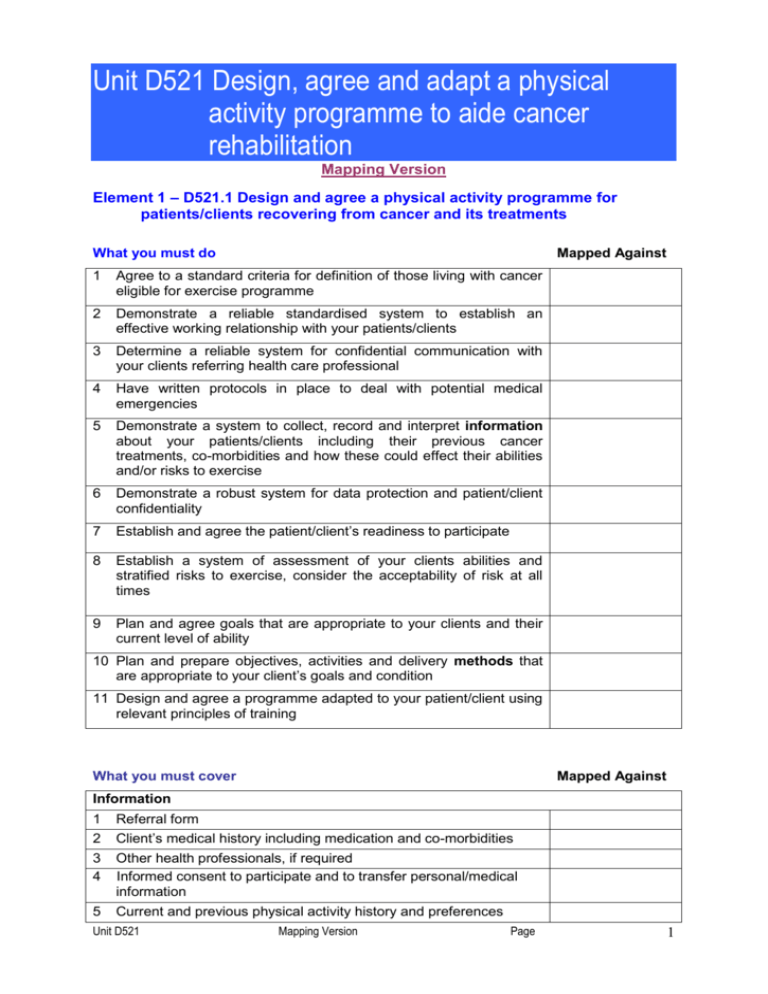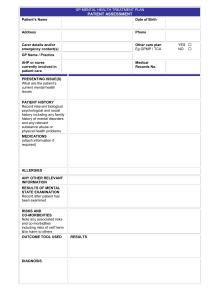Cancer Rehab Mapping Toolkit
advertisement

Unit D521 Design, agree and adapt a physical activity programme to aide cancer rehabilitation Mapping Version Element 1 – D521.1 Design and agree a physical activity programme for patients/clients recovering from cancer and its treatments What you must do Mapped Against 1 Agree to a standard criteria for definition of those living with cancer eligible for exercise programme 2 Demonstrate a reliable standardised system to establish an effective working relationship with your patients/clients 3 Determine a reliable system for confidential communication with your clients referring health care professional 4 Have written protocols in place to deal with potential medical emergencies 5 Demonstrate a system to collect, record and interpret information about your patients/clients including their previous cancer treatments, co-morbidities and how these could effect their abilities and/or risks to exercise 6 Demonstrate a robust system for data protection and patient/client confidentiality 7 Establish and agree the patient/client’s readiness to participate 8 Establish a system of assessment of your clients abilities and stratified risks to exercise, consider the acceptability of risk at all times 9 Plan and agree goals that are appropriate to your clients and their current level of ability 10 Plan and prepare objectives, activities and delivery methods that are appropriate to your client’s goals and condition 11 Design and agree a programme adapted to your patient/client using relevant principles of training What you must cover Mapped Against Information 1 2 3 4 Referral form Client’s medical history including medication and co-morbidities Other health professionals, if required Informed consent to participate and to transfer personal/medical information 5 Current and previous physical activity history and preferences Unit D521 Mapping Version Page 1 6 Specific disabilities and points of specific concerns for exercise 7 Relevant social and psychological considerations 8 Personal goals and expectations for the forthcoming programme 9 Ongoing behavioural changes Methods 1. Reports 2. Interview 3. Questionnaires 4. Observations 5. Validated functional assessments Element 2 – D521.2 Deliver, review and adapt a physical activity programme for patients/clients recovering from cancer and its treatments What you must do Mapped Against 1 Deliver planned activities with your patient/client (and carer if appropriate), predetermined in the referral and assessment process 2 Have an ongoing system of monitoring and assessment in order to ensure activity goals are met and/or adapt them according to clients evolving needs and abilities 3 Have an ongoing system of monitoring in order to assess the risk of continuing exercise programme 4 If necessary manage medical emergencies until appropriate medical help is available 5 Communicate and consult with your patients/clients with sensitivity and empathy on issues to do with their physical activity programme and progress 6 Provide appropriate attention to your patients/clients with common co-morbidities 7 Support your patient/client in a way which will motivate and promote sustained change in physical activity levels whether within a structured exercise programme or elsewhere 8 Enable your patients/clients to take part in unsupervised exercise on their own 9 Monitor your patient/client’s progress against agreed goals and adapt the programme accordingly 10 Communicate adverse events with the referring clinician What you must know and understand Mapped Against K1 Relevant current government and NHS policy and guidelines for living with cancer K2 Awareness of national agencies and organisations relating to living with cancer Unit D521 Mapping Version Page 2 K3 Relevant medico-legal issues K4 The structure of UK cancer services and the roles of different professionals involved in the care of the patient at the various stages in their management pathway K5 How to interact and communicate appropriately with the referring clinician or other relevant professional particularly the specialist nurses K6 How to ensure the patient’s condition meets the recommended guidelines for eligibility for referral to community based exercise K7 The physiology and pathology of cancer K8 The environmental/risk factors that can cause cancer and the factors which help our bodies defend against it K9 The main cancer treatments and management pathways particularly surgery, radiotherapy, hormone therapy, chemotherapy and biological therapies K10 The potential effects of cancer surgery and how these can influence the safety and ability to exercise K11 The potential side effects of chemotherapy and how these can influence the safety and ability to exercise K12 The potential side effects of radiotherapy and how these can influence the safety and ability to exercise K13 The potential side effects of hormone therapies and how these can influence the safety and ability to exercise K14 The potential side effects of biological therapies and how these can influence the safety and ability to exercise K15 The published evidence that exercise and lifestyle can reduce the short and long term risk of relapse after initial treatments and improve long term survival K16 The published evidence that exercise and lifestyle can reduce the risk of cancer, reduce the risk of relapse after initial treatments and improve long term survival K17 The underlying mechanisms of how exercise and lifestyle helps improve morbidity and outcomes after cancer treatments K18 Demonstrate communication skills and compassion for patients/clients who have suffered the physical and psychological trauma of cancer and its management K19 Motivational processes, models and techniques involved in behavioural change for the referred patient/client who have suffered the physical and psychological trauma of cancer and its management K20 How to establish a safe and stimulating activity environment sensitive to the physical and psychological, confidentially needs of patients/clients within cancer including the appropriateness of group or individual therapies K21 How to assess, interpret and record a clients baseline parameters within the categories of cardio-respiratory endurance, muscular strength and endurance, flexibility, range Unit D521 Mapping Version Page 3 of motion, balance, body composition based on their physical and psychological parameters related to their cancer but also considering other associated medical conditions such as diabetes, anxiety, depression, hypertension, arthritis, osteoporosis, cardiac disease which may be associated with cancer treatments K22 Individual risk stratification using recognised guidelines K23 How to design an individualised exercise programme based on the initial assessment K24 How to determine which baseline parameters can be monitored during the forthcoming exercise program in order to assess ongoing effectiveness and if necessary modify the programme and offer alternative exercises K25 How to prepare and undertake appropriate ongoing screening in order to detect a change in their condition; what to look out for during exercise K26 How to identify when to consult the relevant health care professionals K27 How to ensure carers are comfortable with the principles of the exercise prescription K28 How to respond safely, appropriately and manage medical complications until appropriate medical help is available K29 General advice to motivate and encourage increased physical activity for the long term K30 The important general lifestyle factors after cancer and the ability to signpost clients to suitable written materials regarding weight control, adequate protein intake relevant to the level of exercise, healthy and unhealthy diets, supplements, smoking, sun exposure, carcinogens and environmental pollutants K31 The management, evaluation and reporting of information, in verbal and written formats Unit D521 Mapping Version Page 4



